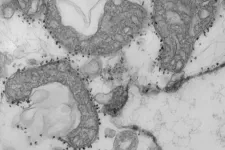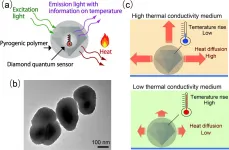(Press-News.org) One of the most vexing aspects of the COVID-19 pandemic is doctors' inability to predict which newly hospitalized patients will go on to develop severe disease, including complications that require the insertion of a breathing tube, kidney dialysis or other intensive care. Knowledge of a patient's age and underlying medical conditions can help predict such outcomes, but there are still surprises when younger, seemingly healthier patients suffer severe complications that can lead to death.
Now, scientists at Washington University School of Medicine in St. Louis have shown that a relatively simple and rapid blood test can predict -- within a day of a hospital admission -- which patients with COVID-19 are at highest risk of severe complications or death.
The study, published Jan. 14 in JCI Insight, involved nearly 100 patients newly admitted to the hospital with COVID-19.
The blood test measures levels of mitochondrial DNA, a unique type of DNA molecule that normally resides inside the energy factories of cells. Mitochondrial DNA spilling out of cells and into the bloodstream is a sign that a particular type of violent cell death is taking place in the body.
"Doctors need better tools to evaluate the status of COVID-19 patients as early as possible because many of the treatments -- such as monoclonal antibodies -- are in short supply, and we know that some patients will get better without intensive treatments," said co-senior author Andrew E. Gelman, PhD, the Jacqueline G. and William E. Maritz Endowed Chair in Immunology and Oncology in the Department of Surgery.
"There's so much we still don't understand about this disease," he added. "In particular, we need to understand why some patients, irrespective of their ages or underlying health in some cases, go into this hyperinflammatory death spiral. Our study suggests that tissue damage may be one cause of this spiral, since the mitochondrial DNA that is released is itself an inflammatory molecule."
The researchers said the test could serve as a way to predict disease severity as well as a tool to better design clinical trials, identifying patients who might, for example, benefit from specific investigational treatments. They also said they would like to evaluate whether the test could serve as a way to monitor the effectiveness of new therapies. Presumably, effective treatments would lower mitochondrial DNA levels.
"We will need larger trials to verify what we found in this study, but if we could determine in the first 24 hours of admission whether a patient is likely to need dialysis or intubation or medication to keep their blood pressure from dropping too low, that would change how we triage the patient, and it might change how we manage them much earlier in the disease course," said co-senior author Hrishikesh S. Kulkarni, MD, an assistant professor of medicine.
The researchers, including co-first authors Davide Scozzi, MD, PhD, a staff scientist, and Marlene Cano, PhD, a postdoctoral research scholar, evaluated 97 patients with COVID-19 at Barnes-Jewish Hospital, measuring their mitochondrial DNA levels on the first day of their hospital stays. They found that mitochondrial DNA levels were much higher in patients who eventually were admitted to the ICU, intubated or died. The researchers found this association held independently of a patient's age, sex and underlying health conditions.
On average, mitochondrial DNA levels were about tenfold higher in patients with COVID-19 who developed severe lung dysfunction or eventually died. Those with elevated levels were almost six times more likely to be intubated, three times more likely to be admitted to the ICU and almost twice as likely to die compared with those with lower levels.
Further, the test predicted outcomes as well as or better than existing markers of inflammation currently measured in patients hospitalized with COVID-19. Most other markers of inflammation measured in patients with COVID-19, including those still under investigation, are general markers of systemic inflammation, rather than inflammation specific to cell death, according to the researchers.
"Viruses can cause a type of tissue damage called necrosis that is a violent, inflammatory response to the infection," Gelman said. "The cell breaks open, releasing the contents, including mitochondrial DNA, which itself drives inflammation. In COVID-19 patients, there has been anecdotal evidence of this type of cell and tissue damage in the lung, heart and kidney. We think it's possible that measures of mitochondrial DNA in the blood may be an early sign of this type of cell death in vital organs."
The researchers also emphasized that the test is quick and straightforward to perform in most hospital settings because it uses the same machinery that processes the standard PCR test for COVID-19. The method they developed allows mitochondrial DNA levels to be quantified directly in the blood. Without requiring intermediate steps to extract the DNA from the blood, the technique returned results in less than an hour.
Before they can apply for approval from the Food and Drug Administration (FDA), the scientists will need to verify that the test is accurate in a larger multi-center trial. They have plans to expand the research to more sites.
The study utilized samples obtained from the School of Medicine's COVID-19 biorepository, which was developed by co-authors Jane O'Halloran, MD, PhD, an assistant professor of medicine; Charles Goss, PhD, an instructor in biostatistics; and Phillip Mudd, MD, PhD, an assistant professor of emergency medicine.
INFORMATION:
This work was supported by the Barnes Jewish Hospital Foundation; the Children's Discovery Institute; the National Institutes of Health (NIH), grant numbers, R01HL094601, P01AI116501 and K08HL148510; and the Washington University Institute of Clinical and Translational Sciences (ICTS) COVID-19 Research Program, which is funded by the National Center for Advancing Translational Sciences (NCATS) of the NIH, grant number UL1TR002345.
Scozzi D, Cano M, et al. Circulating mitochondrial DNA is an early indicator of severe illness and mortality from COVID-19. JCI Insight. Jan. 14, 2021.
Washington University School of Medicine's 1,500 faculty physicians also are the medical staff of Barnes-Jewish and St. Louis Children's hospitals. The School of Medicine is a leader in medical research, teaching and patient care, ranking among the top 10 medical schools in the nation by U.S. News & World Report. Through its affiliations with Barnes-Jewish and St. Louis Children's hospitals, the School of Medicine is linked to BJC HealthCare.
MIAMI--A group of more than 60 scientists have provided recommendations to improve the Indian Ocean Observing System (IndOOS), a basin-wide monitoring system to better understand the impacts of human-caused climate change in a region that has been warming faster than any other ocean.
The group, led by Lisa Beal, professor of ocean sciences at the University of Miami (UM) Rosenstiel School of Marine and Atmospheric Science, provides a road map for an enhanced IndOOS to better meet the scientific and societal needs for more reliable environmental forecasts in the next decade. The 136 actionable recommendations from the three-year, internationally coordinated review were published in the Bulletin of the American Meteorological Society.
The scientists call for four major ...
A University of Saskatchewan study has found that the COVID-19 pandemic has led to significant worsening of already poor dietary habits, low activity levels, sedentary behaviour, and high alcohol consumption among university students.
The findings of the study--the first to assess changes in students' dietary intake, physical activity, and sedentary behaviour before and during the pandemic--are published today in the journal Applied Physiology, Nutrition and Metabolism.
"Our findings are important because university students, especially those most vulnerable for poor nutrition and sedentary behaviour, should be targeted for interventions aimed at maintaining and improving physical activity and dietary practices during this pandemic and beyond," said lead author ...
As the vaccination of older adults against COVID-19 begins across the country, new poll data suggests that many of them don't yet have access to the "patient portal" online systems that could make it much easier for them to schedule a vaccination appointment.
The poll finds that 45% of adults aged 65 to 80, and 42% of all adults aged 50 to 80, said they had not set up an account with their health provider's portal system. That's according to the newly analyzed data from the National Poll on Healthy Aging, based at the University of Michigan's Institute for Healthcare Policy and Innovation.
The new number actually represents some progress: 49% of adults in the same age range hadn't set up patient portal access the last time the ...
Exactly what kills a person with COVID-19?
How do those deaths differ from the deaths of people whose lungs fail rapidly because of other infections or injuries?
And what can hospital teams pressed into service on overtaxed COVID-19 wards do to try to keep patients from dying, despite strained circumstances?
All of these questions have sparked discussion - and even conspiracy theories - since the pandemic began. Now, two studies from Michigan Medicine may help answer them.
The bottom line: COVID-19 deaths are indeed different from other lung failure deaths. But, the researchers conclude, the kind of care needed to help sustain people through the worst cases of all forms of lung failure is highly similar. It just needs to be fine-tuned to focus on the ...
Scientists have uncovered new clues implicating a type of herpes virus as the cause of a central nervous system disease in monkeys that's similar to multiple sclerosis in people.
The findings, published in the Annals of Clinical and Translational Neurology, expand on previous work to understand the cause of the disease and potentially develop antiviral therapies. The work was led by scientists at Oregon Health & Science University.
"This gives us a better understanding of the model," said Scott Wong, Ph.D., senior author of the study and a scientist at the OHSU Vaccine and Gene Therapy Institute and the Oregon National Primate Research Center. "It draws more parallels to MS in people."
The new study reveals the presence of two kinds of T cells, a type of ...
In groundbreaking materials research, a team led by University of Minnesota Professor K. Andre Mkhoyan has made a discovery that blends the best of two sought-after qualities for touchscreens and smart windows--transparency and conductivity.
The researchers are the first to observe metallic lines in a perovskite crystal. Perovskites abound in the Earth's center, and barium stannate (BaSnO3) is one such crystal. However, it has not been studied extensively for metallic properties because of the prevalence of more conductive materials on the planet like metals or semiconductors. The ...
Osaka, Japan - A team of scientists from Osaka University, The University of Queensland, and the National University of Singapore's Faculty of Engineering used tiny nanodiamonds coated with a heat-releasing polymer to probe the thermal properties of cells. When irradiated with light from a laser, the sensors acted both as heaters and thermometers, allowing the thermal conductivity of the interior of a cell to be calculated. This work may lead to a new set of heat-based treatments for killing bacteria or cancer cells.
Even though the cell is the fundamental unit of all living organisms, some physical properties have remained difficult to study in vivo. For example, a cell's thermal conductivity, as well as the rate that heat can flow through an object if ...
Berkeley -- Most frogs emit a characteristic croak to attract the attention of a potential mate. But a few frog species that call near loud streams -- where the noise may obscure those crucial love songs -- add to their calls by visually showing off with the flap of a hand, a wave of a foot or a bob of the head. Frogs who "dance" near rushing streams have been documented in the rainforests of India, Borneo, Brazil and, now, Ecuador.
Conservation ecologist Rebecca Brunner, a Ph.D. candidate at the University of California, Berkeley, has discovered that the glass frog ...
Plant pathologists working at universities across 26 corn-producing states in the United States and in Ontario, Canada, compiled data about annual corn reductions caused by diseases. Estimated loss from each disease varied greatly by region.
"This group of plant pathologists takes a step back to estimate what has gone wrong in corn fields in each of their states," said Iowa State University plant pathologist Daren Mueller, who was involved in this project. "Collectively, and across years, corn disease loss estimates provide folks a zoomed out view of what diseases are affecting corn in the U.S. and Canada."
To Mueller, these data represent one of the pieces of a good research project. Researchers can use these data to justify new research projects that can help mitigate the impacts ...
The U.S. fishing and seafood sector generated more than $200 billion in annual sales and supported 1.7 million jobs in recent years. It experienced broad declines in 2020 as a result of the COVID-19 public health crisis, according to a new NOAA Fisheries analysis released today. While losses vary by sector, by region and by industry, data and information from this report may help businesses and communities assess losses and inform long-term recovery and resilience strategies.
According to analysts, COVID-19 protective measures instituted in March across the United States and globe contributed to an almost-immediate impact on seafood sector sales. There was a strong start to the year, with ...




